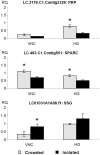Transcriptome analysis of the desert locust central nervous system: production and annotation of a Schistocerca gregaria EST database
- PMID: 21445293
- PMCID: PMC3061863
- DOI: 10.1371/journal.pone.0017274
Transcriptome analysis of the desert locust central nervous system: production and annotation of a Schistocerca gregaria EST database
Abstract
Background: The desert locust (Schistocerca gregaria) displays a fascinating type of phenotypic plasticity, designated as 'phase polyphenism'. Depending on environmental conditions, one genome can be translated into two highly divergent phenotypes, termed the solitarious and gregarious (swarming) phase. Although many of the underlying molecular events remain elusive, the central nervous system (CNS) is expected to play a crucial role in the phase transition process. Locusts have also proven to be interesting model organisms in a physiological and neurobiological research context. However, molecular studies in locusts are hampered by the fact that genome/transcriptome sequence information available for this branch of insects is still limited.
Methodology: We have generated 34,672 raw expressed sequence tags (EST) from the CNS of desert locusts in both phases. These ESTs were assembled in 12,709 unique transcript sequences and nearly 4,000 sequences were functionally annotated. Moreover, the obtained S. gregaria EST information is highly complementary to the existing orthopteran transcriptomic data. Since many novel transcripts encode neuronal signaling and signal transduction components, this paper includes an overview of these sequences. Furthermore, several transcripts being differentially represented in solitarious and gregarious locusts were retrieved from this EST database. The findings highlight the involvement of the CNS in the phase transition process and indicate that this novel annotated database may also add to the emerging knowledge of concomitant neuronal signaling and neuroplasticity events.
Conclusions: In summary, we met the need for novel sequence data from desert locust CNS. To our knowledge, we hereby also present the first insect EST database that is derived from the complete CNS. The obtained S. gregaria EST data constitute an important new source of information that will be instrumental in further unraveling the molecular principles of phase polyphenism, in further establishing locusts as valuable research model organisms and in molecular evolutionary and comparative entomology.
Conflict of interest statement
Figures






Similar articles
-
Microarray-based transcriptomic analysis of differences between long-term gregarious and solitarious desert locusts.PLoS One. 2011;6(11):e28110. doi: 10.1371/journal.pone.0028110. Epub 2011 Nov 23. PLoS One. 2011. PMID: 22132225 Free PMC article.
-
Comparative transcriptomics suggests a highly species-specific nature of the phenotypic plasticity associated with the outbreaks of the two main pest locusts.BMC Genomics. 2024 Dec 19;25(1):1222. doi: 10.1186/s12864-024-11020-8. BMC Genomics. 2024. PMID: 39701934 Free PMC article.
-
Neuroparsin transcripts as molecular markers in the process of desert locust (Schistocerca gregaria) phase transition.Biochem Biophys Res Commun. 2006 Mar 10;341(2):599-606. doi: 10.1016/j.bbrc.2006.01.011. Epub 2006 Jan 13. Biochem Biophys Res Commun. 2006. PMID: 16427604
-
Epigenetics and locust life phase transitions.J Exp Biol. 2015 Jan 1;218(Pt 1):88-99. doi: 10.1242/jeb.107078. J Exp Biol. 2015. PMID: 25568455 Review.
-
Peptides in the locusts, Locusta migratoria and Schistocerca gregaria.Peptides. 1997;18(1):145-56. doi: 10.1016/s0196-9781(96)00236-7. Peptides. 1997. PMID: 9114464 Review.
Cited by
-
Transcriptomic Analysis of Aedes aegypti in Response to Mosquitocidal Bacillus thuringiensis LLP29 Toxin.Sci Rep. 2018 Aug 23;8(1):12650. doi: 10.1038/s41598-018-30741-x. Sci Rep. 2018. PMID: 30140020 Free PMC article.
-
A step to the gigantic genome of the desert locust: chromosome sizes and repeated DNAs.Chromosoma. 2015 Jun;124(2):263-75. doi: 10.1007/s00412-014-0499-0. Epub 2014 Dec 5. Chromosoma. 2015. PMID: 25472934
-
Evolutionarily conserved TRH neuropeptide pathway regulates growth in Caenorhabditis elegans.Proc Natl Acad Sci U S A. 2017 May 16;114(20):E4065-E4074. doi: 10.1073/pnas.1617392114. Epub 2017 May 1. Proc Natl Acad Sci U S A. 2017. PMID: 28461507 Free PMC article.
-
Evolution, expression and association of the chemosensory protein genes with the outbreak phase of the two main pest locusts.Sci Rep. 2017 Jul 27;7(1):6653. doi: 10.1038/s41598-017-07068-0. Sci Rep. 2017. PMID: 28751682 Free PMC article.
-
The endoparasitoid, Cotesia vestalis, regulates host physiology by reprogramming the neuropeptide transcriptional network.Sci Rep. 2015 Feb 2;5:8173. doi: 10.1038/srep08173. Sci Rep. 2015. PMID: 25640113 Free PMC article.
References
-
- Stone JV, Mordue W, Batley KE, Morris HR. Structure of locust adipokinetic hormone, a neurohormone that regulates lipid utilisation during flight. Nature. 1976;263:207–211. - PubMed
-
- Gade G, Goldsworthy GJ, Kegel G, Keller R. Single step purification of locust adipokinetic hormones I and II by reversed-phase high-performance liquid chromatography, and amino-acid composition of the hormone II. Hoppe-Seyler's Z Physiol Chem. 1984;365:393–398. - PubMed
-
- Schoofs L, Vanden Broeck J, De Loof A. The myotropic peptides of Locusta migratoria: structures, distribution, functions and receptors. Insect Biochem. 1993;23:859–881. - PubMed
-
- Schoofs L, Veelaert D, Vanden Broeck J, De Loof A. Peptides in the locusts, Locusta migratoria and Schistocerca gregaria. Peptides. 1997;18:145–156. - PubMed
-
- Clynen E, Schoofs L. Peptidomic survey of the locust neuroendocrine system. Insect Biochem. 2009;39:491–507. - PubMed
Publication types
MeSH terms
Substances
LinkOut - more resources
Full Text Sources
Research Materials
Miscellaneous

